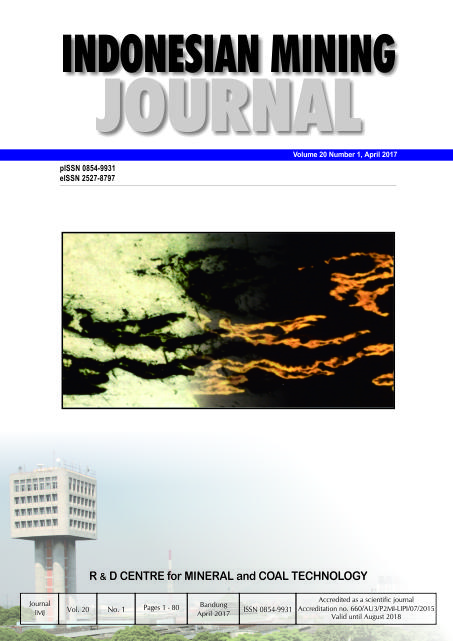Indexed by:
Vol. 20 No. 1 (2017): INDONESIAN MINING JOURNAL VOL. 20 NO. 1 April 2017

As announced at the October 2016 Indonesian Mining Journal, commencing the year 2017, this journal is periodically published twice annually, which is in April and October. Hopefully, quality of this journal can substantially be maintained. The editors really expect that all article contributors remain to write their contribution for the continuity of this journal.
Apparently, Indonesia’s strategic issues on mineral and mining sector are still available to discuss for the stakeholders, particularly in implementing good mining practices, which are value-added mineral and coal. In January 2017, the Indonesian government has made three policies, which is 1). Peraturan Pemerintah Nomor 1 Tahun 2017 (PP No.1/2017 or Government Regulation No.1/2017). This new regulation is the fourth change of PP No.23/2010 concerning the implementation of mining business on mineral and coal; 2). Peraturan Menteri ESDM No.5/2017 or Ministerial Regulation No.5/2017), and 3). Peraturan Menteri ESDM No.6/2017 or Ministerial Regulation No.6/2017. The main point of these regulations is a permission in exporting concentrate and raw material for nickel and bauxite with certain terms. These terms are 1). The mining company has a status of Izin Usaha Pertambangan (IUP or Mining Permit) and Izin Usaha Pertambangan Khusus (IUPK or Special Mining Permit), 2). The building of smelter at the limit of five years after the release of those regulations, 3). Share divestment at least 51%, and 4). Export tax until 10%.
The Law No. 4/2009 concerning the mineral and coal mining has already been issued and applied in this country. It is really expected that the law and those above regulations can assure law certainty and business; economic growth and national and regional revenue; regional development and participation of global business and regional community; social development for community by strengthening regional institution and using local content (raw material and human resources); and environmental conservation that can guarantee ecosystem continuity. The mining operation has a significant role in providing real value-added toward the national economic growth and the sustainable national development. The mining business permit holder has a compulsory to improve value added of mineral and coal resources in implementing mining operation, processing and utilization. This processing activity must absolutely be carried out in the country. By creating value-added, the selling price of the products will multiply increase. Automatically, the foreign exchange and the tax in the country will increase as well. The other benefit is that the downstream industry will grow and create a new job that has a potency of the regional economic growth.
In order to cope with the all above issues, the role of R&D centre of the mineral and coal sector is really expected to perfectly complete related regulations. The role consists of, among others, 1). Policy assessment for the making of academic paper, 2). Guidance in monitoring the construction of smelters, and 3). Research on environmental impacts of mining activity, post-mining and sustainable development.
After reading and assessing all the mining issues, it is absolutely expected that the certain new law and the implementing regulations on mineral and coal mining business, particularly the various regional regulations, will accommodate the golden bridge between R&D centre (supply aspect) and industries (demand aspect), which can synergize of the supply-demand on the mineral and coal commodities in accordance with the specific and characteristic products.











